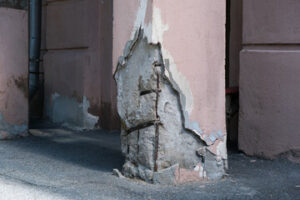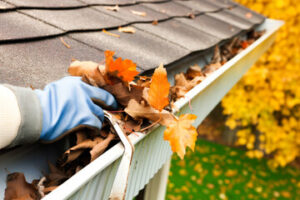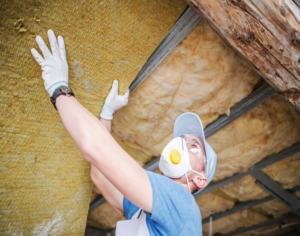The longevity of Concrete Repair is impacted by several factors. Most importantly, the repair material must be adequately moist-cured.

Construction practices such as surface preparation and curing also have a significant impact. The key is to develop a concrete repair method that delivers the desired durability properties of the repaired structure.
When concrete cracks, it can be a sign of serious problems that can lead to serious structural damage. It is important to repair these cracks as soon as they appear to avoid further damage and prevent moisture, mold, mildew, or other contaminants from settling into the concrete and damaging the structure.
To repair concrete cracks, first clean the area around the crack with a wire brush or power washer to remove any dirt or debris that may be clogging the pores in the concrete. Then, a layer of bonding adhesive should be applied to the surface of the concrete to help the repair materials adhere. This is often overlooked, but it’s crucial for long-term durability.
For minor to moderate cracks, the next step is to use a concrete patching compound to fill the cracks in the concrete. This can be a caulk tube, bottle or pre-mixed compound. Once the compound has been troweled into the cracks, it should be leveled with a trowel to create a smooth and even surface. This will help the cracks to blend into the rest of the concrete and prevent them from widening or re-cracking in the future.
If the cracks in your concrete are severe, you will need to use a different method to fix them. Structural repairs must be completed by a professional and done in accordance with the Engineer of Record’s specifications.
This is why it’s so important to work with a reputable contractor that has experience in the type of repair you need. In addition, it’s essential to choose the correct products for your repair. UNIQUE offers an array of high-quality concrete repair products, so you’ll be sure to find the right one for your needs.
A popular option for repairing cracks in concrete stairs is vinyl concrete patching compound. This works well on cracks that are not heaving, and it’s easy to apply. Before using the compound, clean the cracked stair area and scrub it with a wire brush to remove any loose dirt or paint. Then, cover the area with a plastic sheet to protect it. Then, sand the rough edges of the cracked stairs with a power grinder to smooth them. Finally, tape a piece of paper to the back of a plank and place it on top of the staircase to mark the length of each step.
Repairing Spalling
Spalling is one of the most serious problems that afflict concrete. It’s when the top layer of concrete flakes off, leaving the surface patchy and pitted while exposing aggregate underneath. If left unattended, the damage can spread quickly. Spalling is not only unsightly, but it can also compromise the strength and longevity of your concrete slab. If you see signs of spalling, it’s important to call a concrete repair expert immediately.
The most effective solution will depend on the severity of the spalling and the cause of the deterioration. It may be a case of excessive water intruding into the concrete, or poor mixing during construction. Exposure to freezing and thawing cycles, as well as deicing chemicals or salts, can increase the risk of spalling.
A thorough condition evaluation will help to determine the cause of the problem and provide an informed recommendation on the best concrete repair method. This should include a review of design and construction documents, structural analysis of the structure in its deteriorated condition, visual inspection, destructive and nondestructive testing, corrosion activity monitoring, and laboratory results from chemical and petrographic analysis of concrete samples.
Regardless of the repair method selected, a long moist-curing period will be required to ensure a successful outcome. Concrete repair materials should be selected based on durability properties including cracking resistance, permeability and freeze-thaw performance. Concrete repair methods should be designed to ensure the concrete structure is properly re-positioned and backfilled in relation to its original design.
Once the damaged concrete is removed, the substrate should be cleaned to remove contaminating materials and to prepare it for the application of the repair material. If the underlying steel reinforcements are exposed, they should be protected using Type 1 discrete anodes or concrete cathodic protection. The concrete repair material should be applied and smoothed with a trowel or brush to closely match the appearance of the surrounding concrete. After the repair, a water sealant should be applied to prevent moisture from entering joints and contributing to future damage. Follow the directions on the repair product to determine curing times and procedures.
Repairing Loose Concrete
Concrete can shift and settle over time, causing loose or unsound sections. If left unattended, this deterioration can lead to structural damage, leaks and other issues that will require costly repairs. A thorough inspection of the concrete structure is needed to determine the causes and the best repair method. The evaluation can include a review of existing design and construction documents, a visual inspection of the structure, destructive and nondestructive testing and laboratory results from chemical and petrographic analysis of concrete samples.
Loose concrete can be repaired using a number of methods, including replacement, injection, and shotcreting. Injection and spraying are the most common repairs for loose concrete, although replacement can also be used if it is the most cost-effective solution. The concrete repair process is a complex procedure that requires special tools, training and experience to achieve the desired results. Injection uses high-pressure injection pipes that are inserted into the damaged area and then injected with a grout mixture. This method can be effective in repairing small areas or entire slabs.
Shotcreting involves shooting a mixture of cement, water and aggregate through a nozzle onto the surface of the damaged concrete. This is a fast-setting method that can be used in a variety of applications, including the repair of large cracks and spalling, and can be done with minimal disruption to the surrounding environment.
Concrete repair is a critical part of maintaining safe and functional surfaces, but it can be challenging without the right equipment or expertise. Working with a professional contractor who has access to the proper equipment and materials is the best way to ensure that your repair project is completed correctly and will last.
When choosing a concrete repair contractor, be sure to do your research and ask for references. Additionally, be sure to walk through the repair site before handing over any cash so that you know what will be done and can avoid surprises down the road. Taking safety precautions, allocating sufficient time and budget, considering professional help when necessary, and practicing proper maintenance are all important factors in ensuring successful concrete repair projects.
Repairing Damaged Slabs
Slabs in concrete can suffer from damage that needs to be repaired. This can include surface stains, mold, water intrusion and structural problems.
It’s best to hire a professional concrete contractor to repair any slab damage because it can be dangerous and requires expert knowledge to complete the work correctly. It’s also important to use high-quality materials to ensure the repairs last long and are safe.
The most common form of slab damage is cracking. This can be caused by freeze-thaw cycles, strain from the slab settling or trauma from heavy equipment and vehicles. Injecting epoxy or polyurethane resin into the slab can help to fill these cracks and create a strong bond that prevents water penetration and further damage.
If the damage is severe, it may be necessary to replace the concrete. This can be done by removing the existing concrete, preparing the site and pouring a new concrete slab. A professional concrete contractor can determine if replacing the concrete is required and will recommend the best course of action for the situation.
In addition to repairing cracks and spalling, a contractor can repair damage to concrete surfaces, such as pitting or rough surface texture. These issues can be caused by soil compaction, poor construction or heavy loads. Adding an overlay or more concrete to the surface can even out uneven surface texture and prepare it for hard floorings. However, this is not an ideal solution for exterior slabs because it will be exposed to constant moisture and temperature fluctuations, which can cause it to chip away.
It’s important to clean the concrete surface before making any repairs. Oil stains and other discolorations can be removed with stain-fighting products and pressure washing. It’s also a good idea to seal the concrete after repairs are made to minimize water intrusion, keep dirt from collecting and prevent weeds from growing.
When hiring a concrete repair contractor, look for a company that offers warranties and insurance. This will give you peace of mind that the job will be completed properly and safely, and you’ll have coverage if any accidents or damage occurs during the process.




